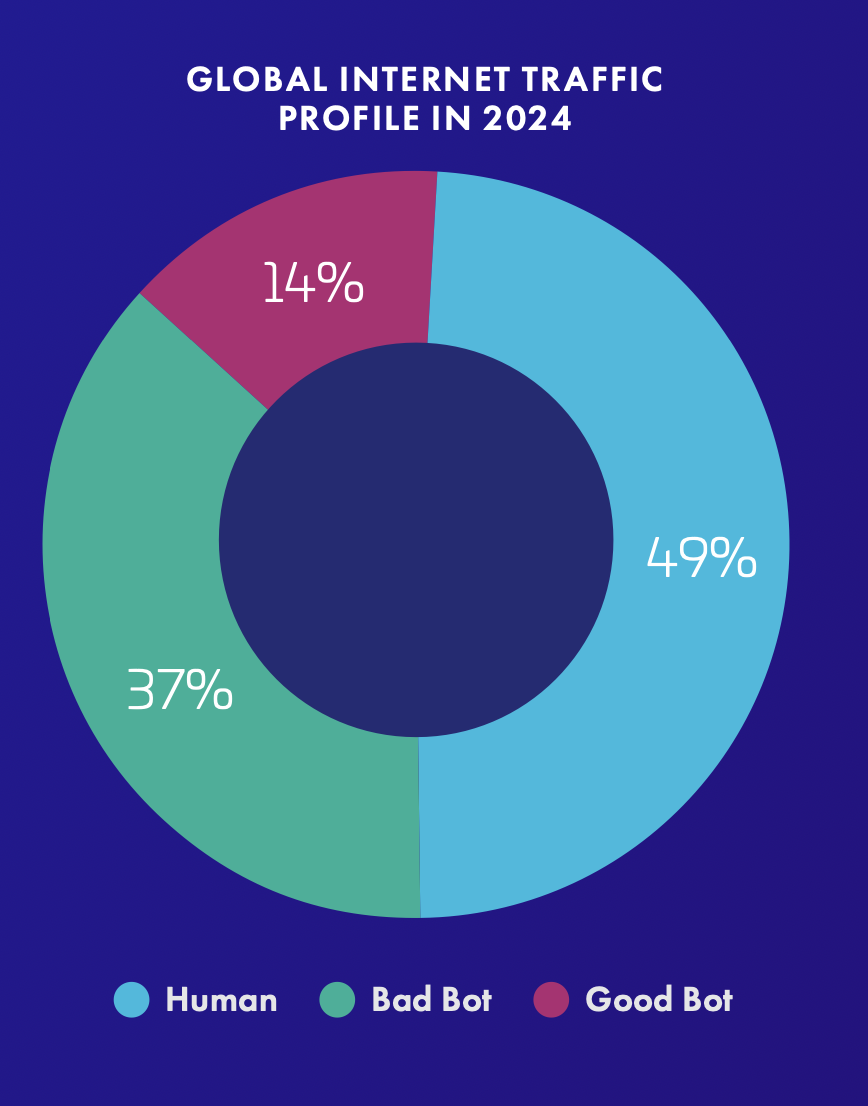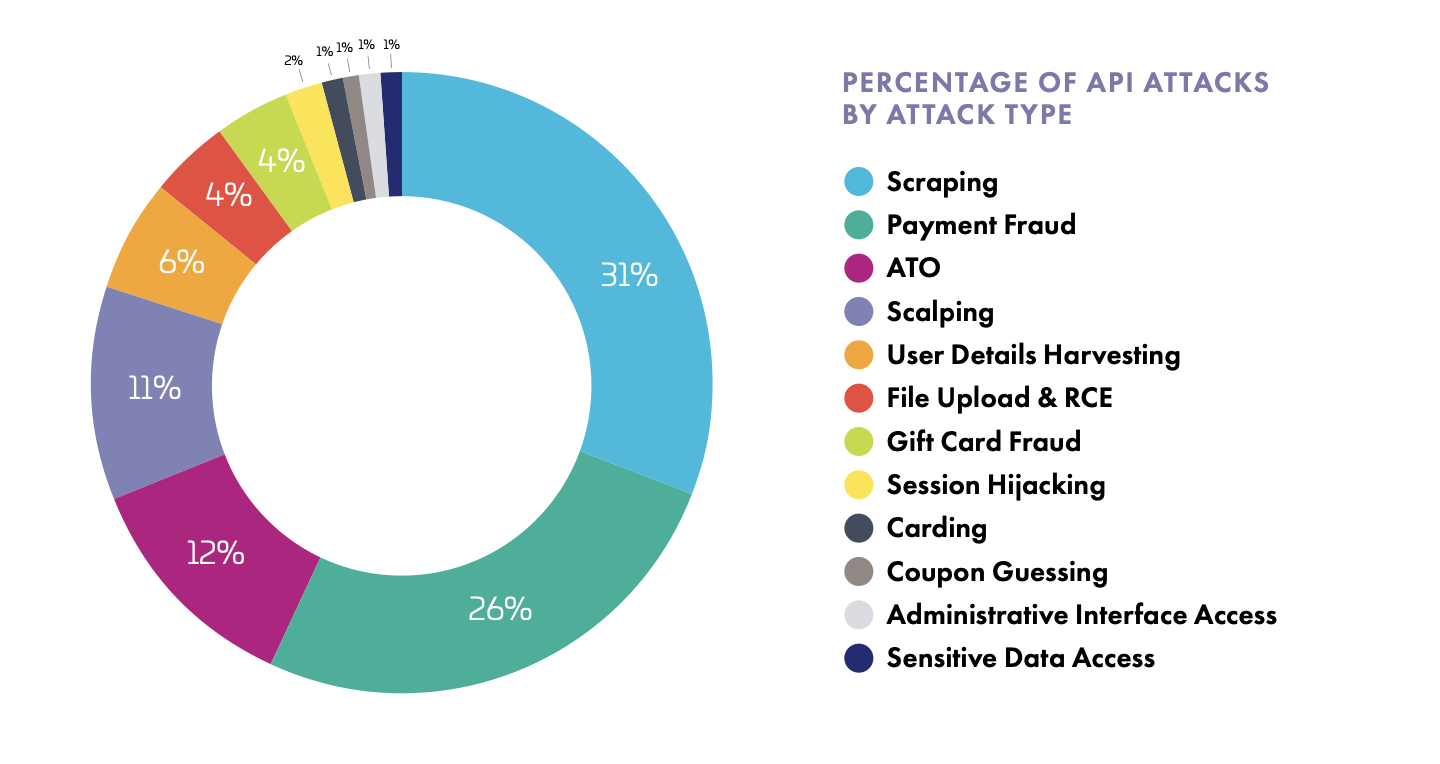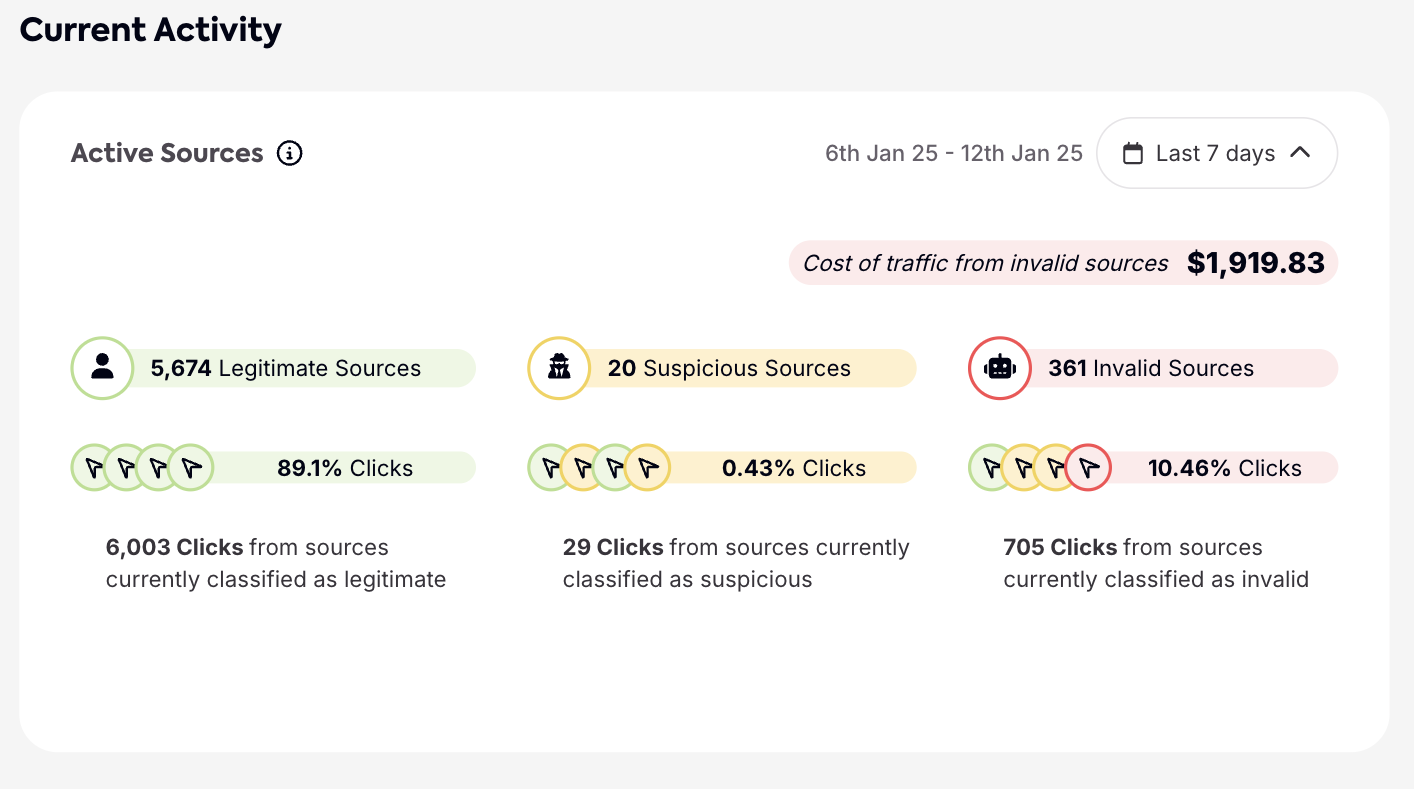Bot traffic has long been a problem for advertisers. Good or bad, bots can drain your ad budget and skew your PPC results if you don’t have the right protection in place. And with the rise of AI, digital advertising is becoming even more vulnerable to the bots that cause click fraud.
Automated bots now account for more than half of all traffic, with bad bots making up a huge 37% of internet traffic, according to the 2025 Imperva Bad Bot Report:

The explosive rise of AI tools like ChatGPT has democratized access to bot-building tools, so it’s easier than ever for bad actors to create and deploy bots. So we’re not only seeing more automated traffic, but more sophisticated bots, too.
AI isn’t just making bots smarter - it’s making click fraud harder to detect and more expensive for advertisers. But there are ways to counteract this rise in AI bot traffic and keep your ads safe from click fraud.
Let’s take a look at how AI is causing a boom in ad fraud, and how you can combat it effectively.
AI’s role in the evolution of bot traffic
In 2024, Imperva blocked a whopping 2 million+ AI-powered cyberattacks every day, including DDoS attacks, custom rules exploitation, and API violations. So AI is capable of producing a whole range of different attack vectors.
Generative AI tools have quickly lowered the barrier to entry for cybercriminals. Those with minimal coding skills can now generate bots for dozens of types of malicious online activity.
AI helps cybercriminals build more evasive bots. As language learning models (LLMs) learn more about human behavior, the line between human vs bot activity is increasingly blurred. AI can convincingly emulate human behavior, such as mouse movements, clicks, and CAPTCHA resolution. So traditional tactics used to block traffic bots are becoming less effective.
With AI tools, bad bots can also be generated at scale. According to Imperva’s report:
“Simple, high-volume bot attacks have grown substantially, now comprising 45% of all bot attacks—up from 40% in 2023. This rise can be attributed to the increasing accessibility of AI-powered automation tools, which allow attackers with less technical expertise to launch bot attacks easily.”
But the concerns don’t end there. Attackers are also using AI to analyze performance so they can build stronger, more evasive bots. AI helps unearth the reasons for failed attacks and refine bot programming to evade detection more effectively.
What click fraud looks like in the AI era
Click fraud - illegitimate clicks on paid media ads that drain your ad budget without generating results - is likely to rise with these new AI bot traffic tactics.
Bots have long been used to commit click fraud and generate invalid traffic (IVT). But with these new AI developments, you can expect to see more fake clicks and form fills from fake users. That means more wasted ad budget, a higher rate of fake leads, and increasingly skewed performance data.
Case in point: According to Imperva’s report, one global talent agency found that 83% of its website traffic came from bad bots - despite spending over $100,000 on ads. The sheer volume of fake traffic made it impossible to measure campaign performance accurately, ultimately undermining their recruitment goals.
Not all agencies saw this level of bad bot infiltration: the average is 53%. But that’s still more than half of all site traffic coming from bad bots that won’t just not convert - they actively drain your ad spend, invalidate your results, and waste your resources.
Click fraud: the real-world impact on ad performance
Click fraud is on the rise in the AI era. So what does that actually mean for your ad performance?
- Invalid clicks drain your ad budget without generating valuable conversions. So you’ll get a low return on your investment.
- Clicks from bots are still counted in performance metrics, rendering your data inaccurate and unreliable.
- Algorithms rely on clean data to generate good results - bots can mess up your data, leading to algorithmic skewing that compromises future as well as past performance.
- All of these consequences ultimately lead to ROI cannibalization across your paid media campaigns, leading to lower ad revenue overall.
Or, as Imperva puts it:
“Bad bots drain marketing budgets and crush ROI expectations.”
How ai-based bots evade detection
Sophisticated bots are increasingly able to avoid detection, and AI is making it even easier. Here are the most advanced evasion techniques powered by AI.
Browser spoofing
AI-driven bots use residential proxies and browser impersonation techniques (such as Chrome spoofing) to mimic real user behavior. Imperva reports that 46% of bad bots impersonated Chrome to blend in with genuine users.
Residential proxies route bot traffic through actual devices with legitimate IP addresses, making it look like real traffic. Bots can also impersonate popular browsers by spoofing browser fingerprints (such as screen resolution and user agent strings).
Combining these tactics minimizes the risk of IVT detection, helping bots bypass traditional anti-bot measures (like IP blacklisting and CAPTCHA).
Leveraging headless browsers
Unlike normal browsers, headless browsers (such as Puppeteer and Playwright) operate without a graphical user interface. When combined with AI-assisted scripting, bots can use headless browsers to render web pages and interact with them as a human would - all without using an actual interface.
LLMs generate dynamic scripts that enable bots to respond to changes in content naturally. This helps them fly under the radar by simulating realistic user journeys.
Bots-as-a-Service (BaaS)
Bots-as-a-Service platforms offer ready-to-launch click fraud kits that make sophisticated bot operations accessible even to non-technical users. Click fraud kits are pre-configured with features such as those listed above, so users can launch bad bots pretty much straight out of the box.
BaaS bots frequently rotate IP addresses, spoof browser fingerprints, and adapt to changing anti-fraud measures in real time. By packaging these capabilities into easy-to-use services, BaaS operators enable widespread, scalable click fraud that’s difficult for detection systems to distinguish from legitimate traffic.
Bypassing CAPTCHA
In 2025, more than 40% of the top 100,000 websites (by traffic) use CAPTCHA forms to block bots. Even without AI, CAPTCHA has faced challenges detecting and blocking the most sophisticated bots. But AI-driven bots can now swiftly solve CAPTCHA challenges, making this popular system increasingly ineffective.
API exploitation in performance advertising
APIs are now a prime target for advanced IVT. According to Imperva, 44% of sophisticated bots targeted APIs in 2024, versus just 10% that targeted web applications. This signals a deliberate shift in attacker tactics: they’re actively targeting sensitive and high-value data handled within APIs.

Source: Imperva Bad Bot Report 2025
As the graph above shows, bots target APIs in lots of different ways. So how is performance marketing vulnerable to API attacks?
In performance advertising, APIs are used for real-time bidding, ad placement, attribution, and conversion tracking, among other activities. Malicious bots exploit these endpoints to:
- Spoof bid requests to inflate ad revenue or divert it to themselves.
- Spoof ad impressions to inflate ad revenue.
- Artificially inflate bid prices by masquerading as high-value targets.
- Create fake conversion or attribution API calls to generate revenue.
- Gain a strategic edge by scraping valuable business logic, pricing data, and performance metrics from the API.
This increase in API targeting reflects a broader shift in ad fraud: from crude bot traffic to more sophisticated back-end manipulation.
In plain English: bots are now targeting the backend of your ad systems - where bidding, placement, and tracking happens - instead of just spamming your site.
How to prevent AI bot traffic affecting your marketing campaigns
With the rise in scope and scale of AI-powered click fraud schemes, what can you really do to minimize their impact? And is there a way to stop them affecting your campaigns altogether? Let’s take a look at the options.
1. Block invalid traffic with a dedicated platform
The easiest way to reduce the impact of malicious AI bot traffic on your campaigns is also the most effective. When you partner with an effective invalid traffic prevention platform, all your traffic is routed through IVT detection systems that block bad bots in real-time.
Lunio verifies all your ad traffic, allowing only clicks from genuine users that have a real chance of conversion. Our sophisticated machine learning algorithms are constantly learning about and refining their targets, keeping up with even the most sophisticated AI bots.

Plus, Lunio protects all mainstream ad campaigns and platforms - check out our ad traffic quality solutions to learn more.
Choosing a third-party platform may seem expensive, but it can actually save you money over time. Our customers, Graff, saved and reallocated a six-figure ad spend sum within three months of using Lunio. We offer a free two-week traffic audit so you can see how much IVT is affecting your campaigns - and get a real-world look at how much of your ad budget Lunio could help you save.
2. Analyze your traffic for anomalies
Want to keep your traffic analysis in-house? It is possible to use Google Analytics and other reporting tools to spot the signs of invalid traffic and detect anomalies manually:
- High bounce rate - In general, a bounce rate of more than 70% may indicate high levels of bot traffic.
- Low session duration - Bots don’t linger on websites in the same way as genuine visitors, so look out for low session duration or dwell time.
- Traffic peaks with low conversion rates - While high traffic volumes can be a sign of success, they may indicate an IVT issue if conversions don’t spike at the same time.
- Suspicious patterns - Bots run on an automatic schedule, so if you notice the same pattern over and over, it may be due to malicious automated traffic.

To use this AI bot traffic prevention method most effectively, you’ll need a good understanding of what normal traffic patterns look like for your site. Get familiar with your data so you can quickly spot and tackle anomalies.
f you’re not sure whether AI-powered bots are hitting your campaigns, here are some common red flags to look for:
- Spikes in traffic without matching conversions - More visits should mean more results. If your conversion rate isn’t keeping pace, something’s off.
- Bounce rate over 70% from unexpected geos - High bounce rates from countries you’re not targeting can indicate bot traffic.
- Repeatable activity patterns - Same number of clicks at the same time every day? Bots often follow strict schedules.
- Surge in branded keyword clicks - Bots often go after branded search terms — inflating CPCs without driving real value.
- Sudden changes in post-click behavior - If session duration, scroll depth, or engagement suddenly drop, bots might be to blame.
The sooner you spot these signs, the faster you can get a free independent traffic audit to confirm your suspicions - and see exactly how much click fraud is costing you.
3. Monitor your API for suspicious activity
APIs are now a key target for cybercriminals, so you’ll need to keep a close eye on your API security. Here’s what you can look for when monitoring your API for AI bot traffic and other suspicious activity:
- Changes to request frequency - An unusually high number of API requests (or a bombardment of requests at an unexpected time) can suggest bots are targeting your API.
- Abnormal API use/business logic attacks - Bots may be able to bypass or manipulate certain steps (such as processing payment) to access your API. Business logic attacks are one of the most common types of AI abuse, accounting for 25% of attacks.
- Unauthorized access attempts - Keep an eye on requests sent without proper authentication. Repeated unauthorized attempts to access restricted resources via your API is often a clear sign of suspicious activity.
- Unusually high error rates - Watch out for spikes in error rates and unusual response codes. This may be a sign of API abuse as attackers attempt brute force entry to your API.
API scrutiny is difficult for those with limited technical knowledge of how they work and their vulnerabilities, so make sure to collaborate with your tech and cybersecurity teams on this.
4. Understand and protect post-click behavior
Understanding your users’ typical behavior post-click can help you stop AI bots from manipulating your ad campaigns.
Tracking codes and cookies have traditionally been used to track site visitor behavior, though these are becoming less prevalent due to the ongoing third party cookie depreciation debacle.
Instead, make sure you’re using Enhanced Conversions within your Google Ads. Enhanced Conversions send first party conversion data from your site to Google without compromising user privacy. So you can learn more about post-click behavior (and stay compliant).
Use post-click data (such as purchases, form submissions, and scroll depth) to identify and block IVT from your site.
How click fraud corrupts smart bidding algorithms
AI click fraud does more than just drain your budget. It actively manipulates the very systems designed to optimise your performance.
Platforms like Google Ads rely on smart bidding to adjust your bids based on the likelihood of conversion. But here’s the issue:
Smart bidding trains on engagement signals, and bots can fake those signals.
When sophisticated AI bots generate clicks, scroll a bit, and bounce, they’re mimicking human behaviour just well enough to be seen as “valuable traffic.”
That creates a feedback loop:
- Bots engage with your ads
- Google’s algorithm thinks it’s good traffic
- It starts bidding more aggressively for similar users
- Your costs go up… for more fake traffic
And it doesn’t stop there. Attribution, audience targeting, and lookalike modelling all get skewed when bot data is in the mix — hurting both current and future campaign performance.
That’s why tackling IVT isn’t just about saving money. It’s about protecting your long-term media efficiency.
Beat AI bot traffic with Lunio’s ad traffic protection tools - powered by AI
AI is redefining the threat landscape in click fraud. And it’s likely to get worse as AI and LLMs continue to learn and advance. That’s why proactive protection measures are vital for maintaining and improving your ad performance.
If your current security setup is leaving you vulnerable to increasingly sophisticated ad fraud techniques, it’s time to make a change.
With Lunio, you can fight fire with fire. Our ad traffic verification and protection software uses AI and machine learning to keep up with evolving threats. We identify and block AI bot traffic threats immediately, keeping your data clean and your ad budget intact.
Learn how Lunio helps performance marketers take back control of their ad spend. Get a 14 day free traffic audit to see how bots are affecting your campaigns today.



-1.png?width=300&name=685c0e27c25ab3c9e935f0ad_Blog%20Header%20GPT%20(1)-1.png)